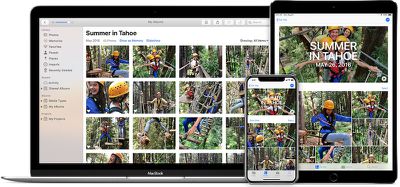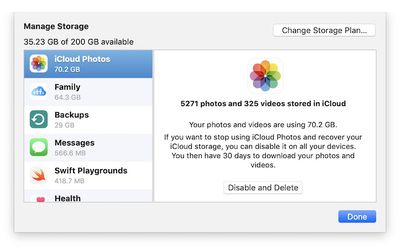How to Upload All Photo One Time to Icloud Drive
iCloud Photos, formerly known as iCloud Photo Library, is an Apple tree service that moves the user's entire photo and video library into the cloud. It's office of Apple's push to brand information technology as like shooting fish in a barrel every bit possible for users to switch amidst Mac and iOS devices throughout the day, making sure the user's photos are available on all of their devices and ensuring whatsoever changes get rapidly synced across devices.

Turning on iCloud Photo Library
- iOS: Open the Settings app and caput to account section and tap on your iCloud business relationship. In the "Apps Using iCloud" section, tap on Photos and you'll find a toggle for iCloud Photos. This pick can as well exist accessed through the Photos app section of Settings.
- macOS: Open up System Preferences and head to the iCloud pane. If y'all're logged in, yous'll see a list of the various iCloud services. Hit the "Options..." button side by side to Photos, and you'll see a window where you tin plow on iCloud Photos. You can also manage settings within the Preferences section of the new Photos app straight.
- Apple Tv: On a 4th-generation Apple TV or Apple TV 4K, head to the Accounts department of Settings, and so choose iCloud and turn on the iCloud Photos option.
- iCloud.com: Photos stored in iCloud Photo Library are also accessible through Apple's spider web-based iCloud.com service. Through the web interface, users can upload or download photos, browse via Moments and Albums view, impress or email photos, and mark individual photos as favorites.
iCloud Photos Settings
The Photos apps for Mac and iOS are built to work with iCloud Photos, although users can opt to utilise local photo libraries on their devices if they adopt. Users opting for iCloud Photos have the choice of storing the original photos on their Mac or iOS device, which is ideal for offline access, or a more flexible optimized arrangement that stores originals locally if you lot have enough storage space but uses lower-resolution versions if local storage is tight and only downloads the full-resolution versions from iCloud equally needed.

iCloud Photos settings on Mac (left) and iOS (right)
Like settings are available on iOS, where users can choose between storing full-resolution photos right on their devices or saving some space past storing lower-resolution versions onboard and keeping the full-resolution versions in iCloud.
On iOS and macOS, users may too keep to meet an choice for My Photo Stream, which is Apple tree's separate service that allows users to automatically sync their last 30 days' worth of photos (upward to one,000 photos) betwixt devices. Users who recently created their Apple IDs may not run into the My Photo Stream option, equally Apple is phasing out the feature.
On devices where iCloud Photos is active, there will no longer be a split up My Photo Stream album every bit there was prior to the rollout of iCloud Photos, every bit all photos are now included in the primary library stored in iCloud. My Photo Stream doesn't count confronting your iCloud storage limits, simply edits made to photos in My Photograph Stream don't update beyond your devices.
The My Photo Stream setting does, nonetheless, offer some level of integration betwixt devices where iCloud Photo Library is enabled and those where it is disabled. Turning on My Photo Stream on a device with iCloud Photo Library is enabled allows the device to import Photo Stream photos from other not-iCloud devices and also send new photos out to My Photograph Stream for display on those devices.
Using iCloud Photos
Once y'all empathize that iCloud Photos stores and syncs photos across devices, usage is very straightforward and information technology behaves very much like a local photograph library stored on the user's motorcar. Users can freely manage, edit, and salvage their photos as they have always done, with the added bonus of that work automatically appearing wherever they have iCloud Photos enabled. The original photos ever remain stored in iCloud, making information technology easy to revert any edits made on a device.
Equally with a local photo library, users tin can include photos from any source, making iCloud Photos more than the alternative Photograph Streams of images taken on their devices. Photos and videos of a wide range of types from any source can exist added to the user'due south library on one device, and they volition sync to all other devices.
One important consideration when deciding whether or not to use iCloud Photos is that information technology is an all-or-none proposition on a given device unless the user chooses to use multiple photo libraries on macOS. With a single photo library, in that location is no pick to sync but some photos while the remainder is stored just locally. For instance, users tin can non opt to have only their iOS device photos synced to their Mac via iCloud Photos simply not have their full library of photos in the Photos app for Mac synced to iCloud and the user's other devices unless they want to manage multiple libraries.
Photos are stored in iCloud Photos at their full resolutions and in their original formats. Mutual formats like HEIF, JPEG, RAW, PNG, GIF, TIFF, HEVC, and MP4 are all supported, every bit are special formats captured on iOS devices like slo-mo, time-lapse, and Live Photos.
Pricing
iCloud Photos taps into a user's iCloud account storage, which is too used for iCloud Drive document storage, device backups, and more. iCloud users receive v GB of storage for free, but users who wish to back upwards their devices to iCloud ofttimes discover they need more than that, and iCloud Photo Library will only increase the demand for boosted storage.
Apple offers several paid storage tiers for iCloud, priced on a monthly basis and ranging from 50 GB to ii TB. The lowest paid plan at 50 GB costs $0.99/calendar month in the U.South., with Apple besides offering a 200 GB plan for $2.99/month and a 2 TB plan for $9.99/month. Even the high-finish two TB plan may not exist enough for some users who have a lot of photos, requiring them to either archive some photos exterior of the service or simply opt to not use iCloud Photos at all.
If you make full upwards your iCloud storage resource allotment, new photos and videos will no longer be uploaded to iCloud, and libraries will no longer exist synced across devices. In order to restore iCloud Photos functionality, users will need to either upgrade to a larger storage programme or reduce storage usage by manually deleting certain photos or other files from iCloud.
Turning Off iCloud Photos
And so what if you've turned on iCloud Photos and afterward decide you don't want to use it anymore, either for a specific device or across all devices? On a specific device, iCloud Photos tin be disabled the same fashion information technology was turned on, through the iCloud portion of the Settings app on iOS device or Organization Preferences or Photos preferences on a Mac. If you lot are currently storing optimized versions of your photos, your system will give yous the opportunity to download the full-resolution photos from iCloud, at which betoken y'all will have a complete local photo library on your device.

Disabling iCloud Photos entirely in iCloud settings on Mac
If you lot adopt to turn off iCloud Photos entirely, you lot can head to the Manage Storage section of iCloud settings either in the Settings app on an iOS device or System Preferences on a Mac. In that section, you tin choose to Disable and Delete iCloud Photo Library, after which point you volition accept xxx days to download your library to at least ane device before it is removed entirely.
Wrap-up
iCloud Photos represents one of Apple'southward key efforts to streamline the experience of using multiple devices, many of which have been bundled under the "Continuity" umbrella. Many of these Continuity features tap into iCloud equally a method for linking diverse devices, and iCloud Photos takes that one step further to ensure the users' photos are bachelor regardless of which device they are currently on.
Related Articles
Apple tree Launches Service for Transferring iCloud Photos and Videos to Google Photos
Apple this week introduced a new service that'due south designed to go far quick and piece of cake for iCloud users to transfer their stored photos and videos to Google Photos. Equally outlined in an Apple back up document, yous can go to Apple tree'southward privacy website and sign in to run into the "Transfer a copy of your data" option. If you select this and go through all the steps, Apple will transfer your iCloud photos and ...
iCloud for Windows 5 Adds iCloud Photo Library and Two-Cistron Authentication
Apple tree has released iCloud for Windows 5 with support for iCloud Photo Library and ii-factor authentication for Apple ID accounts. Windows users were previously limited to accessing iCloud Photo Library through the web interface. Apple recommends that iCloud for Windows users have Windows 7, 8 or 10 installed. For email, the software currently supports Outlook 2007 through Outlook 2013,...
collinssuposincer.blogspot.com
Source: https://www.macrumors.com/guide/icloud-photo-library/
0 Response to "How to Upload All Photo One Time to Icloud Drive"
Post a Comment